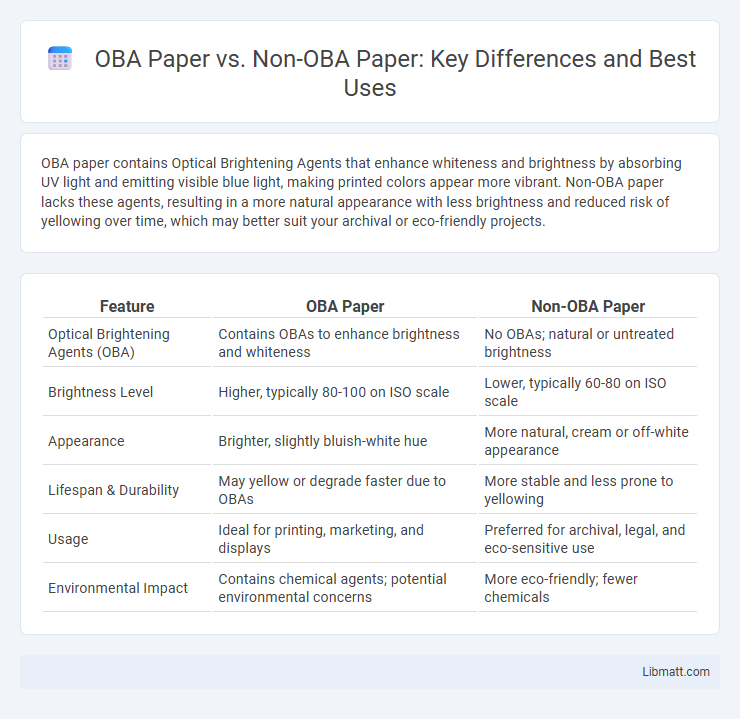OBA paper contains Optical Brightening Agents that enhance whiteness and brightness by absorbing UV light and emitting visible blue light, making printed colors appear more vibrant. Non-OBA paper lacks these agents, resulting in a more natural appearance with less brightness and reduced risk of yellowing over time, which may better suit your archival or eco-friendly projects.
Table of Comparison
| Feature | OBA Paper | Non-OBA Paper |
|---|---|---|
| Optical Brightening Agents (OBA) | Contains OBAs to enhance brightness and whiteness | No OBAs; natural or untreated brightness |
| Brightness Level | Higher, typically 80-100 on ISO scale | Lower, typically 60-80 on ISO scale |
| Appearance | Brighter, slightly bluish-white hue | More natural, cream or off-white appearance |
| Lifespan & Durability | May yellow or degrade faster due to OBAs | More stable and less prone to yellowing |
| Usage | Ideal for printing, marketing, and displays | Preferred for archival, legal, and eco-sensitive use |
| Environmental Impact | Contains chemical agents; potential environmental concerns | More eco-friendly; fewer chemicals |
Introduction to OBA and Non-OBA Paper
OBA paper contains Optical Brightening Agents that absorb ultraviolet light and emit visible blue light, enhancing the paper's brightness and whiteness. Non-OBA paper lacks these agents, resulting in a more natural, less reflective appearance often preferred for archival purposes. The choice between OBA and non-OBA paper impacts printability, durability, and visual quality in various printing and packaging applications.
What Are Optical Brightening Agents (OBAs)?
Optical Brightening Agents (OBAs) are chemical compounds added to paper to enhance its whiteness and brightness by absorbing ultraviolet light and re-emitting it as visible blue light, creating a more vibrant appearance. OBA paper contains these agents, resulting in a brighter, more visually appealing sheet, while non-OBA paper lacks these additives, often appearing duller or slightly yellowish. When choosing paper, understanding the presence of OBAs is crucial for applications requiring vivid color reproduction or high contrast in printing.
Defining Non-OBA Paper
Non-OBA paper is manufactured without Optical Brightening Agents, resulting in a more natural color that does not fluoresce under UV light. Unlike OBA paper, which contains chemical compounds to enhance brightness and whiteness, non-OBA paper offers improved archival qualities and reduced yellowing over time. This makes non-OBA paper ideal for archival documents, artwork, and applications requiring longevity and color stability.
Key Differences Between OBA and Non-OBA Paper
OBA paper contains Optical Brightening Agents that absorb ultraviolet light and emit blue light, enhancing brightness and whiteness, whereas non-OBA paper lacks these agents, resulting in a more natural, less bright appearance. OBA papers tend to fade or yellow faster under prolonged exposure to sunlight due to the chemical breakdown of brightening agents, while non-OBA papers generally offer superior archival quality and longevity. The choice between OBA and non-OBA paper depends on the desired visual impact and durability requirements for specific printing or archival applications.
Visual Appearance and Whiteness
OBA paper contains Optical Brightening Agents that enhance its visual appearance by absorbing ultraviolet light and emitting blue light, resulting in a brighter and whiter look compared to non-OBA paper. Non-OBA paper has a more natural tone, often appearing creamier or off-white, and lacks the intense brightness caused by fluorescent whitening. Choosing between OBA and non-OBA paper affects your project's color vibrancy and the paper's long-term color stability under light exposure.
Impact on Print Quality
OBA paper contains optical brightening agents that enhance whiteness and brightness, resulting in sharper and more vibrant print colors, which improves overall print quality. Non-OBA paper, lacking these agents, tends to produce duller and less vivid prints, especially under natural light or in high-resolution printing. The choice between OBA and non-OBA paper significantly affects color accuracy, contrast, and the longevity of printed materials in professional printing applications.
Longevity and Archival Properties
OBA (Optical Brightening Agent) paper tends to degrade faster over time due to its chemical composition, making it less suitable for long-term archival purposes. Non-OBA paper, often made from acid-free materials, exhibits superior longevity and resistance to yellowing, which ensures better preservation of documents and prints. Archival-quality non-OBA paper is preferred by libraries and museums for maintaining the integrity of important texts and artworks over decades.
Environmental Considerations
OBA (Optical Brightening Agents) paper contains chemical additives that enhance whiteness but can pose environmental concerns due to potential toxicity and reduced recyclability. Non-OBA paper is more eco-friendly, as it avoids such additives, leading to easier recycling and lower chemical impact on ecosystems. Choosing non-OBA paper supports your commitment to sustainable practices by minimizing environmental pollution and promoting greener waste management.
Ideal Applications for OBA vs Non-OBA Paper
OBA (Optical Brightening Agent) paper is ideal for applications requiring enhanced whiteness and brightness, such as high-quality printing, photo paper, and marketing materials where sharp, vibrant colors are crucial. Non-OBA paper suits archival documents, legal papers, and packaging where longevity, reduced fading, and chemical stability are prioritized to prevent yellowing over time. Selecting OBA paper optimizes visual appeal and color contrast, while non-OBA paper ensures durability and resistance to environmental degradation.
Choosing the Right Paper for Your Needs
OBA paper contains optical brightening agents that enhance whiteness and brightness, making it ideal for vibrant printing and professional documents, while non-OBA paper offers greater longevity without color shifting, perfect for archival materials and artwork. Your choice depends on whether you prioritize immediate visual impact or long-term durability. Evaluating the purpose of your project and environmental conditions will guide you to select the most suitable paper type.
OBA paper vs non-OBA paper Infographic

 libmatt.com
libmatt.com